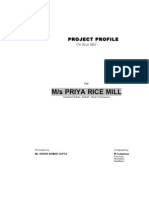0 ratings0% found this document useful (0 votes)
251 viewsNata de Coco
Nata de Coco
Uploaded by
Vignesh SubashNata de coco is a jelly-like substance produced through bacterial fermentation of sugar-enriched coconut water, coconut milk, or other plant extracts. To produce nata de coco from mature coconut water, the water is strained, boiled with sugar and acetic acid, cooled, inoculated with nata de coco culture, and left to ferment for two to three weeks, producing a white jelly surface that is harvested, washed, cut into cubes, and packaged. Setting up a small nata de coco production facility with an annual capacity of 100 liters would require an investment of approximately 500,000 rupees for land, building, and equipment.
Copyright:
© All Rights Reserved
Available Formats
Download as PDF, TXT or read online from Scribd
Nata de Coco
Nata de Coco
Uploaded by
Vignesh Subash0 ratings0% found this document useful (0 votes)
251 views5 pagesNata de coco is a jelly-like substance produced through bacterial fermentation of sugar-enriched coconut water, coconut milk, or other plant extracts. To produce nata de coco from mature coconut water, the water is strained, boiled with sugar and acetic acid, cooled, inoculated with nata de coco culture, and left to ferment for two to three weeks, producing a white jelly surface that is harvested, washed, cut into cubes, and packaged. Setting up a small nata de coco production facility with an annual capacity of 100 liters would require an investment of approximately 500,000 rupees for land, building, and equipment.
Original Description:
Nata de coco manufacturing process
Copyright
© © All Rights Reserved
Available Formats
PDF, TXT or read online from Scribd
Share this document
Did you find this document useful?
Is this content inappropriate?
Nata de coco is a jelly-like substance produced through bacterial fermentation of sugar-enriched coconut water, coconut milk, or other plant extracts. To produce nata de coco from mature coconut water, the water is strained, boiled with sugar and acetic acid, cooled, inoculated with nata de coco culture, and left to ferment for two to three weeks, producing a white jelly surface that is harvested, washed, cut into cubes, and packaged. Setting up a small nata de coco production facility with an annual capacity of 100 liters would require an investment of approximately 500,000 rupees for land, building, and equipment.
Copyright:
© All Rights Reserved
Available Formats
Download as PDF, TXT or read online from Scribd
Download as pdf or txt
0 ratings0% found this document useful (0 votes)
251 views5 pagesNata de Coco
Nata de Coco
Uploaded by
Vignesh SubashNata de coco is a jelly-like substance produced through bacterial fermentation of sugar-enriched coconut water, coconut milk, or other plant extracts. To produce nata de coco from mature coconut water, the water is strained, boiled with sugar and acetic acid, cooled, inoculated with nata de coco culture, and left to ferment for two to three weeks, producing a white jelly surface that is harvested, washed, cut into cubes, and packaged. Setting up a small nata de coco production facility with an annual capacity of 100 liters would require an investment of approximately 500,000 rupees for land, building, and equipment.
Copyright:
© All Rights Reserved
Available Formats
Download as PDF, TXT or read online from Scribd
Download as pdf or txt
You are on page 1of 5
NATA DE COCO
Introduction
Nata-de-coco a cellulosic white to creamy yellow substance formed by acetobacter
aceti subspecies Xylinium, on the surface of sugar enriched coconut water / coconut
milk / plant extract / fruit juices or other waste materials rich in sugar. It is popularly
used as a dessert. It is also used as an ingredient in other food products, such as ice
cream, fruit cocktails, etc.
Process (From Matured Coconut Water)
Initially coconut water is strained and mixed with sugar and glacial acetic acid in
stipulated proportions. Boil for ten minutes and cool. Add the culture solution and
distribute the mixture in wide mouthed glass or plastic jars, cover the jar with a paper
or a thin cloth to protect from dust. It is then kept aside undisturbed for two to three
weeks. After this period, the white jelly like thick surface growth is harvested, washed
thoroughly to remove all the acids and sliced into cubes. It is then immersed in
flavoured sugar solution, again boiled and packed in glass jars or retortable pouches,
sterilized and sealed.
Project Cost
(Capacity 100 litres per day)
Land required
5 cents (cost variable)
Building (500 sq. ft.)
Rs.2.0 lakhs
Equipment /
glassware
Rs.0.5 lakhs
Equipment / Machinery
Available at local glassware / laboratory stores
Yield
Raw material
Finished
product
Salient Features
100 litres of matured coconut water per day
20 kg of nata-de-coco
Annual sales turnover @ Rs.40 / kg
Net profit
Return on investment
Sources of Equipment / Glassware
Glass Vessels
Glass Jars
Sterilized bottles
Measuring cups
Water bath
Refrigerator
Rs.3.75 lakhs
Rs.1 lakh per annum
40 per cent
How to Make Nata de Coco
Nata de Coco is a chewy, translucent, jelly-like substance produced by the
bacterial fermentation of coconut water. It is mixed in one of the most popular
refreshment, the halo-halo, with other stuffs like red beans, macapuno, sweetened
bananas and sweet potatoes, ube and leche flan. There are others stuffs that I forgot to
mention but nata de coco is a mainstay maybe because of its unique taste and
consistency. There have been a craze of this product in the past because it became a hit
in Japan and exported in that country so many ventured on making nata de coco due to
the high demand. But today, the fad diminished but the local demand is still there
because you can still see bottles of nata de coco being sold in the supermarkets. If you
are thinking of business and have plenty of coconuts, then this might be a good start.
The below procedure have two versions, using mature coconut and using fresh coconut.
NATA DE COCO (coconut water) Version 1
RAW MATERIALS
PROCEDURE
NATA DE COCO (tap water) Version 2
RAW MATERIALS
PROCEDURE
You might also like
- Flow Charts of Cassava ProductsDocument23 pagesFlow Charts of Cassava ProductsJDVNo ratings yet
- Application of Water Activity in Tomato Sauce ProcessingDocument7 pagesApplication of Water Activity in Tomato Sauce ProcessingFréÿ ChîkãlîpöNo ratings yet
- A Feasibility Study of Moringa Powder ProductionDocument13 pagesA Feasibility Study of Moringa Powder ProductionSaidamen SaripadaNo ratings yet
- Packaging and Shelflife of CoffeeDocument14 pagesPackaging and Shelflife of CoffeeBeverlyn Abad100% (1)
- Parts List As Per Electric Service TruckDocument3 pagesParts List As Per Electric Service TruckJean Jacques ouandaNo ratings yet
- Banana WineDocument3 pagesBanana WineJunes Gil Gonzales100% (1)
- CH 5 - Intercompany Transaction - InventoriesDocument14 pagesCH 5 - Intercompany Transaction - InventoriesMutia WardaniNo ratings yet
- Nata de CocoDocument16 pagesNata de CocoFebrina Putri R100% (1)
- Coco SapDocument2 pagesCoco SapJames VillanuevaNo ratings yet
- Coconut Based Food Processing Plant-KSIDCDocument7 pagesCoconut Based Food Processing Plant-KSIDCRabia JahaddinNo ratings yet
- Nata de Coco ReadingsDocument9 pagesNata de Coco ReadingsMAE ANGELESNo ratings yet
- How To Produce Nata de CocoDocument21 pagesHow To Produce Nata de CocokalaghanNo ratings yet
- The Procedure of Making Nata de CocoDocument3 pagesThe Procedure of Making Nata de CocoHalimah50% (2)
- Pineapple ProcessingDocument6 pagesPineapple Processingveguruprasad100% (2)
- Priya Rice MillDocument33 pagesPriya Rice MillKonark PoddarNo ratings yet
- Unit 1 Nata de Coco - Id.enDocument37 pagesUnit 1 Nata de Coco - Id.enMuhammad Iqbal100% (1)
- Fruit Juice VinegarDocument1 pageFruit Juice VinegarJan Mikel RiparipNo ratings yet
- A Feasibility Study On The Establishment of Gerocaija Cucumber With Calamansi Juice in Catbalogan CityDocument21 pagesA Feasibility Study On The Establishment of Gerocaija Cucumber With Calamansi Juice in Catbalogan CityRoberto Velasco MabulacNo ratings yet
- Adulteration in JaggeryDocument20 pagesAdulteration in JaggeryWaleed IjazNo ratings yet
- Honeydew Waffle HouseDocument5 pagesHoneydew Waffle HouseBrian AquinoNo ratings yet
- Industrial Lab - Nata de Coco Final ReportDocument6 pagesIndustrial Lab - Nata de Coco Final Reportjr_25_cool100% (1)
- Aen - List of Kitchen Items: Received / Checked byDocument1 pageAen - List of Kitchen Items: Received / Checked bybnjaimahNo ratings yet
- Jam MakingDocument9 pagesJam Makingpinkmawar100% (1)
- Potato and Banana ChipsDocument6 pagesPotato and Banana ChipsNikhil KumarNo ratings yet
- Drying of Fish: Processing of Marine Products (2+0)Document39 pagesDrying of Fish: Processing of Marine Products (2+0)saleekha shamsudheenNo ratings yet
- Avocado PDFDocument8 pagesAvocado PDFMari Rañada SantosNo ratings yet
- Project Report On Mango/tomato Pulp and Ginger Paste & PowderDocument10 pagesProject Report On Mango/tomato Pulp and Ginger Paste & PowderEIRI Board of Consultants and PublishersNo ratings yet
- Industrial Processes: Week-5.1 Beverage ManufacturingDocument11 pagesIndustrial Processes: Week-5.1 Beverage ManufacturingarkinkozNo ratings yet
- Food Additives and PreservativesDocument5 pagesFood Additives and PreservativesNur Adibah Jalaluddin100% (1)
- Waste Utilization From Citrus FruitsDocument21 pagesWaste Utilization From Citrus FruitsVishnupriya RamalingamNo ratings yet
- Fruit Juice Concentrate PlantDocument25 pagesFruit Juice Concentrate Plantbonker508100% (15)
- Fruit Juice ProcessingDocument93 pagesFruit Juice ProcessingPankti Suthar 38No ratings yet
- Papain EnzymeDocument9 pagesPapain EnzymeManish ShankarNo ratings yet
- 2012 SAB Banana ChipsDocument2 pages2012 SAB Banana Chipsjeemee0320No ratings yet
- Production of Soft DrinksDocument5 pagesProduction of Soft DrinksHamsa EhsanNo ratings yet
- Revised Nata de CocoDocument7 pagesRevised Nata de CocoMae Bernadette100% (1)
- Banana Flour ProcessingDocument3 pagesBanana Flour ProcessingLeilani Delgado MoselinaNo ratings yet
- CORN Processing Write-UpDocument12 pagesCORN Processing Write-UpHarbaaz SinghNo ratings yet
- Effect of Size Reduction On The Extraction of Palm Kernel OilDocument41 pagesEffect of Size Reduction On The Extraction of Palm Kernel OilAppeal MatthewNo ratings yet
- Carrot Jam 1Document3 pagesCarrot Jam 1Piolo EsguerraNo ratings yet
- Fruit Juice ConcentratesDocument26 pagesFruit Juice ConcentratesAakash GillNo ratings yet
- Act 4 Wine and Vinegar ProductionDocument17 pagesAct 4 Wine and Vinegar ProductionChris MianaNo ratings yet
- Simply Orange Juice Redesign BookDocument10 pagesSimply Orange Juice Redesign Bookcinyp15No ratings yet
- Clarifying The WaterDocument3 pagesClarifying The WaterPreethi GowdaNo ratings yet
- List of Dairy ProductsDocument22 pagesList of Dairy ProductsAnonymous rGMvFoT3ks100% (1)
- Culture of Freshwater CatfishDocument9 pagesCulture of Freshwater CatfishSandra SENo ratings yet
- Tea Processing PDFDocument3 pagesTea Processing PDFAmal100% (1)
- Catalogo LG Inverter Fan Coil Piso Techo Cassete y Multy Split PDFDocument28 pagesCatalogo LG Inverter Fan Coil Piso Techo Cassete y Multy Split PDFMaxiaires Refrigeracion100% (3)
- Pcarrd 12 2010 - OptDocument32 pagesPcarrd 12 2010 - OptAnders Haagen100% (1)
- Ice Plant RRLDocument17 pagesIce Plant RRLJohn Paul Panganiban SaludaresNo ratings yet
- Housing Systems of PoultryDocument7 pagesHousing Systems of PoultryferdinandNo ratings yet
- Phil Vegetable IndustryDocument63 pagesPhil Vegetable IndustrySylvia Concepcion88% (33)
- Tomato SauceDocument4 pagesTomato Saucekolita kamal100% (1)
- Fruit Juices+Document67 pagesFruit Juices+Geetanshu SinghNo ratings yet
- Mixed Fruit Jam Jelly Pickle MakingDocument6 pagesMixed Fruit Jam Jelly Pickle MakingKirtiKumar KasatNo ratings yet
- Cassava Starch Prod VietnamDocument15 pagesCassava Starch Prod VietnamdinhhuutuyenNo ratings yet
- The Critical Control Points of Making Starter of Nata de CocoDocument4 pagesThe Critical Control Points of Making Starter of Nata de CocoandikaNo ratings yet
- Nata de Coco From Coconut WaterDocument1 pageNata de Coco From Coconut WaterKukuh PramuditoNo ratings yet
- Coconut Juice Ice CreamDocument8 pagesCoconut Juice Ice CreamMc Jason LaureteNo ratings yet
- Kyla Business PlanDocument27 pagesKyla Business Planbelinda dagohoyNo ratings yet
- FARMNEWS - Pcaarrd - Department of Science and TechnologyDocument39 pagesFARMNEWS - Pcaarrd - Department of Science and TechnologyimlaphiNo ratings yet
- Biolab 6Document16 pagesBiolab 6Jenica RiaNo ratings yet
- Punjab Waqf Rules, 2018Document46 pagesPunjab Waqf Rules, 2018Loveroop SinghNo ratings yet
- Writing For The Media by Sandra Pesmen PDFDocument215 pagesWriting For The Media by Sandra Pesmen PDFAndreea BuciumanNo ratings yet
- RX-K Rx-King Oil PumpDocument1 pageRX-K Rx-King Oil PumpDevii AryaNo ratings yet
- Aec1 Chapter 1Document4 pagesAec1 Chapter 1James Paolo RazalNo ratings yet
- Alpha JP-501Document4 pagesAlpha JP-501yinNo ratings yet
- Eee4024 Computer-Architecture-And-Organization TH 1.0 37 Eee4024Document3 pagesEee4024 Computer-Architecture-And-Organization TH 1.0 37 Eee4024Anbarasan SubramaniyanNo ratings yet
- Code of Commerce (Transpo) PDFDocument7 pagesCode of Commerce (Transpo) PDFmonmonmonmon21No ratings yet
- MRK Institute of Technology MRKDocument2 pagesMRK Institute of Technology MRKgunaNo ratings yet
- Gen Air TestDocument14 pagesGen Air TestPRINCE SHARMA100% (1)
- Spa Bir TransferDocument3 pagesSpa Bir TransferElamar de Leon100% (1)
- Crimpro - Digest (3) 22 - Magestrado - V - People - Rule - 111 - 1PDocument1 pageCrimpro - Digest (3) 22 - Magestrado - V - People - Rule - 111 - 1PJestherin Baliton100% (1)
- Vaadin FlowDocument14 pagesVaadin FlowAnandhuBalanNo ratings yet
- Basic Statistics (Course Outline)Document1 pageBasic Statistics (Course Outline)Yohannes AlemuNo ratings yet
- ManualDocument68 pagesManualMariana Marinez MoralesNo ratings yet
- SM10LZ47-Triac ToshibaDocument3 pagesSM10LZ47-Triac ToshibanegrusrlNo ratings yet
- ME 322: Manufacturing Processes: SemesterDocument2 pagesME 322: Manufacturing Processes: SemesterNawaf Al-TamimiNo ratings yet
- Engine Torque & HorsepowerDocument5 pagesEngine Torque & HorsepowerStephen SpiteriNo ratings yet
- Benefit Illustration: UIN: 104N116V04 Page 1 of 2Document2 pagesBenefit Illustration: UIN: 104N116V04 Page 1 of 2vivek0955158No ratings yet
- Input Output Functions in CDocument27 pagesInput Output Functions in CTathagat TripathyNo ratings yet
- Core - Security.patterns - Best.practices - And.strategies - for.J2EE - Web.services - And.identity - Management.oct.2005 0131463071Document848 pagesCore - Security.patterns - Best.practices - And.strategies - for.J2EE - Web.services - And.identity - Management.oct.2005 0131463071blackstileNo ratings yet
- Investment in Subsidiary Problem A - Equity Model and Cost ModelDocument7 pagesInvestment in Subsidiary Problem A - Equity Model and Cost ModelJessica IslaNo ratings yet
- PracticumDocument15 pagesPracticumapi-276696399No ratings yet
- Alcatel-Lucent Omnipcx Enterprise Communication Server: Abc-Ip Logical LinkDocument46 pagesAlcatel-Lucent Omnipcx Enterprise Communication Server: Abc-Ip Logical Linkjuan50% (2)
- English Activity Sheet: Quarter 2 - MELC 3Document11 pagesEnglish Activity Sheet: Quarter 2 - MELC 3Tipa JacoNo ratings yet
- Andhra Pradesh Society For Knowledge Networks Signs Deal With Autodesk ADocument3 pagesAndhra Pradesh Society For Knowledge Networks Signs Deal With Autodesk ApradeepkallurNo ratings yet
- John Bullseye ExerciseDocument4 pagesJohn Bullseye ExerciseErrata BNo ratings yet
- HEAT EXCHANGERS MDocument143 pagesHEAT EXCHANGERS MHeet Patel100% (1)
- Fluid Mechanics & Hydraulics Lab: (Minor Head Losses)Document9 pagesFluid Mechanics & Hydraulics Lab: (Minor Head Losses)Ali Ib TarshaNo ratings yet

























































































